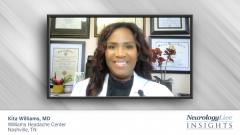
Nonpharmacological Options and Lifestyle Changes for Migraine Management
A migraine specialist discusses nonpharmacological treatment options and their use for migraines.
Episodes in this series

Kita Williams, MD: Regarding lifestyle changes and nonpharmacological options available to treat patients with migraines, in recent years, much of the literature has focused on the effectiveness of nonpharmacological approaches for headaches, and these deserve particular attention in both research and clinical practice. These approaches include noninvasive neuromodulation, such as transcranial magnetic stimulation, vagus nerve stimulation, and caloric vestibular stimulation. There’s also a nonpainful remote electrical skin stimulation and nutraceuticals which are herbal remedies that include feverfew, butterbur, magnesium, or coenzyme Q10. You also have behavioral approaches. These are all increasingly seen as valid treatment options, particularly for specific individuals, such as individuals with medication overuse headaches or those who cannot tolerate more pharmaceutical medications, such as an individual who is pregnant. If you have a pregnant patient, they may be unable to take one of the newer medicines because there is a possibility of birth defects or studies have not been done with pregnant or lactating women. This is where alternative modalities would come into play; they could also come into play with children as well. More investigation is needed into the long-term effects of these medications and to better understand the effectiveness of these approaches, even for different types of headaches. It’s also possible to obtain more standardized and generalizable protocols to do tests for larger patient populations. There haven’t been extreme amounts of testing and data for these modalities. Regarding the nutraceuticals, many patients believe that they don’t have to worry about any adverse effects; they can take it and not worry about anything. That is the biggest misconception; just because something is considered herbal doesn’t mean it doesn’t have adverse effects and doesn’t mean you can take it with whatever else you’re taking. I always ask, “What medicines are you on?” and “What other medications are you taking that would fall under the category of herbal, vitamins, or something like that?” Because they don’t often mention those during their clinic visits.
I have had patients who utilized neuromodulation or the transplant magnetic stimulation, and I have heard varying comments from patients as to whether they are receiving relief. Many of them say they have received relief. But by showing up in my clinic…I only see the ones who aren’t benefiting. At one time there was a trend of getting the tragus pierced, and those patients would come to the neurology clinic. Individuals ask me, “Does that piercing help?” And I tell them that for the ones who come to me and have that piercing, obviously it didn’t help, or they would not be in my neurology clinic. In fairness, patients who have those modalities of treatment will say they it gave them some relief initially, but usually they are still seeking help for their migraine pain. Regarding nutraceuticals, I’ve used some of those as well. Namely, the coenzyme Q10, butterbur, and magnesium. Those have had some benefit for patients, but usually, I will also have them on pharmacological treatment.
I identify a patient who should be considered for nonpharmacological treatment…by someone who cannot receive pharmacological treatment because of age restriction. Maybe they’re an adolescent and the medicine we want to try is not approved for that age group, or maybe they’re a pregnant patient and not a good candidate for the medication either. In those situations, my first approach is to see whether I can find some type of medication that would not be harmful and that they could take and tolerate despite their age or the fact that they are pregnant. That’s the first thing that I go to, and usually that is a combination of a steroid dose pack, Phenergan, and Benadryl. Those have been safe for me to give to an adolescent, and speaking with my obstetrician-gynecologist colleagues, those are safe for my pregnant patients. I always call their obstetrician-gynecologist to discuss this first with each patient and see at what point it’s fine for me to give this patient the steroid dose pack. It is not something I would give without having a conversation with them first, because there are potential adverse effects to giving a steroid dose pack to an individual who’s pregnant, depending on the trimester they are in. If we went into a situation where I could not give them any of these therapies, it would be a perfect time to talk about the nonpharmacological treatments.
Transcript Edited for Clarity
Newsletter
Keep your finger on the pulse of neurology—subscribe to NeurologyLive for expert interviews, new data, and breakthrough treatment updates.


























